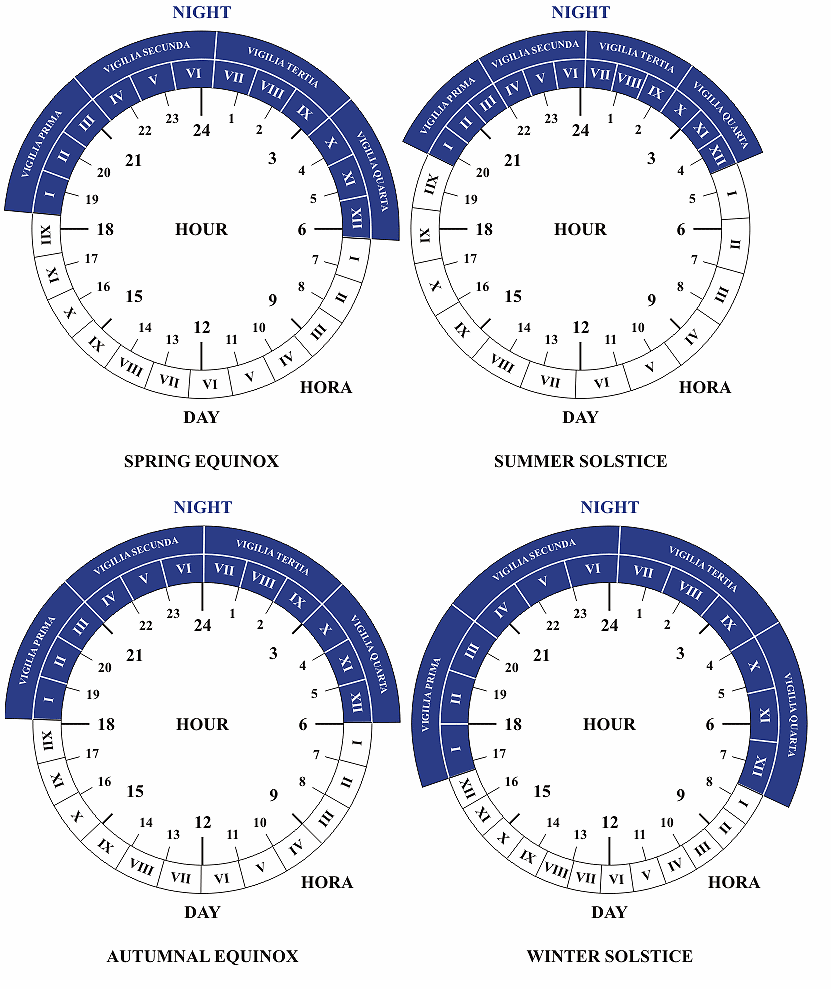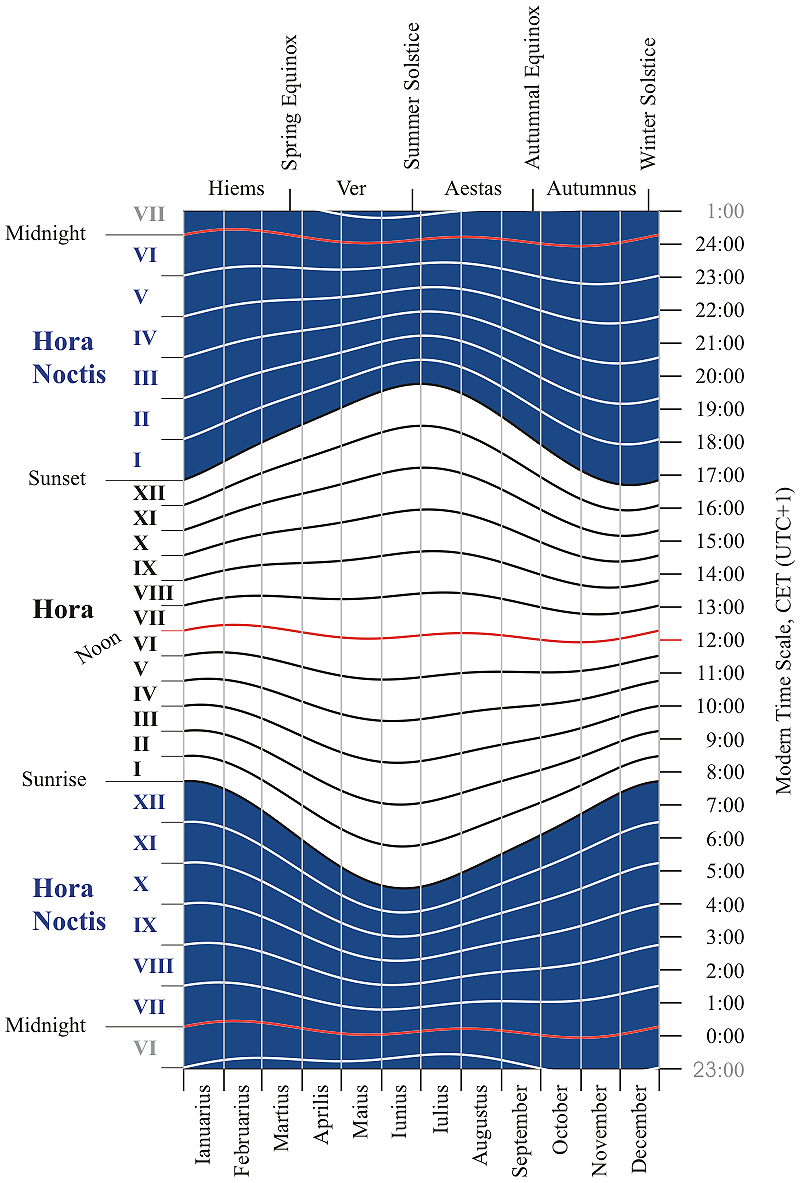That days have 24 hours is a long-established convention, which is also related to the rotational motion of the Earth. Pliny the Elder expressed it as a fact that left no room for doubt:
The world thus formed is not at rest, but rotates eternally with indescribable speed, each revolution occupying the space of 24 hours: sunrise and sunset leave no room for doubt. If the sound of this vast, incessantly revolving mass is of enormous volume and therefore beyond the capacity of our ears to perceive it, I cannot easily say for my part.
Pliny the Elder, Natural History
But, surprisingly enough, the hours didn't always last the same. And it is that before clocks existed, even after the invention of sundials, it was difficult to keep track of time.

Sundial at the Temple of Apollo in Pompeii. Photo: Mentnafunangann/Wikimedia Commons
That is why in ancient Rome, just as the Greeks had done before, a method that was as simple as it was practical was applied: there were 12 hours from when the sun rose until it set, and another twelve from when it set until it rose again. This was implemented in 293 BC, when the sundial was installed in the temple of the god Quirinus. Before that the days were not divided into hours, and in fact the word was not even mentioned in the Twelve Tables (the legislation that stood at the foundation of Roman law), where only dawn and dusk, and the periods before and after noon, were cited.
The division of day and night into twelve hours is not ignored by anyone, but I think it was observed in Rome, only after the invention of the sundial
Censorinus On Christmas day 23
One hour of the day therefore corresponded to 1/12 of the time of daylight. This made the duration of each hour different depending on the latitude and the time of year. Because while the hours of light and darkness are practically the same throughout the year at the equator, the time of light shortens in winter and lengthens in summer in the rest of the planet, with a more pronounced difference the further north or south one goes.
Thus, at a latitude similar to that of the city of Rome, an hour of light at the summer solstice lasted about 75 minutes, while an hour of light at the winter solstice lasted 45 minutes (however, it was not until the Middle Ages they subdivided the hours into minutes and seconds). Because the time of light in the summer solstice lasted six hours longer than in the winter, and this made both the first and last hours lengthen.

Duration and distribution of night and day on equinoxes and solstices of the year AD 8. Image by Darekk2/Wikimedia Commons
This is where the greatest differences were concentrated, since the central hours such as the sixth and, in particular, the seventh, when most jobs were resumed after naps (from the sixth hour after lunch) suffered little variation. In fact, the seventh hour began at the same time point in both summer and winter.
Néstor Marqués in his book A Year in Ancient Rome collects the structure of a calendar day (different from the civil day, which began at midnight and lasted until the following midnight): the calendar day began at dawn with the solis ortus or sunrise Sun; then came the morning (mane ) followed by the meridies or noon, and after it the afternoon (postmeridiem ). The last hour of light was the supreme , followed by the solis occasus , the sunset. Just before dusk (vespera ) the twilight occurred, giving way to night (nox ). It was time to sleep (concubium ) before the mean nox . From there the imtempesta nox spread, until finally the roosters began to sing again in the gallicinium during the last moments of darkness (ante lucem ) and the first lights (dilculum ) that preceded a new dawn.
Each time received a numbered name 1 to 12, that is, first hour, secunda hour, tertia time, etc. And to differentiate the hours of the day from those of the night, prima diei hora (first hour of the day) or prima noctis hora (first hour of the night) was specified .

Diagram illustrating the Roman system of time keeping. Image by Darekk2/Wikimedia Commons
The Romans knew perfectly well this difference in the length of the hours, even more evident when they began to use sundials and water clocks. Pliny the Elder, when he speaks of the parallels in which the world is divided, says:
At this latitude, at noon at the time of the equinox, a 7 foot long sundial hand casts a shadow no more than 4 feet long, while the longest night and longest day contain 14 equinoctial hours, and the shortest on the contrary 10
Pliny the Elder, Natural History
It would not be until 159 BC, when Publius Cornelius Scipio Nasica installed the first water clock (brought from Greece) in the Basilica Emilia del Foro, that the hours of day and night were divided equally.
The lines of this sundial did not match the hours, but they followed it anyway for 99 years, until Quinto Marcio Filipo, who was a censor with Lucio Paulo, placed a more carefully designed one next to it, and this gift was received. as one of the most welcome of the censor's companies. However, even then the hours were uncertain when the weather was cloudy, until the next five years, when Publio Cornelio Scipio Nasica instituted the first water clock that divided the hours of the nights and the days equally.
Pliny the Elder, Natural History
This article was originally published in La Brújula Verde. It has been translated from Spanish and republished with permission.



Comments
Post a Comment